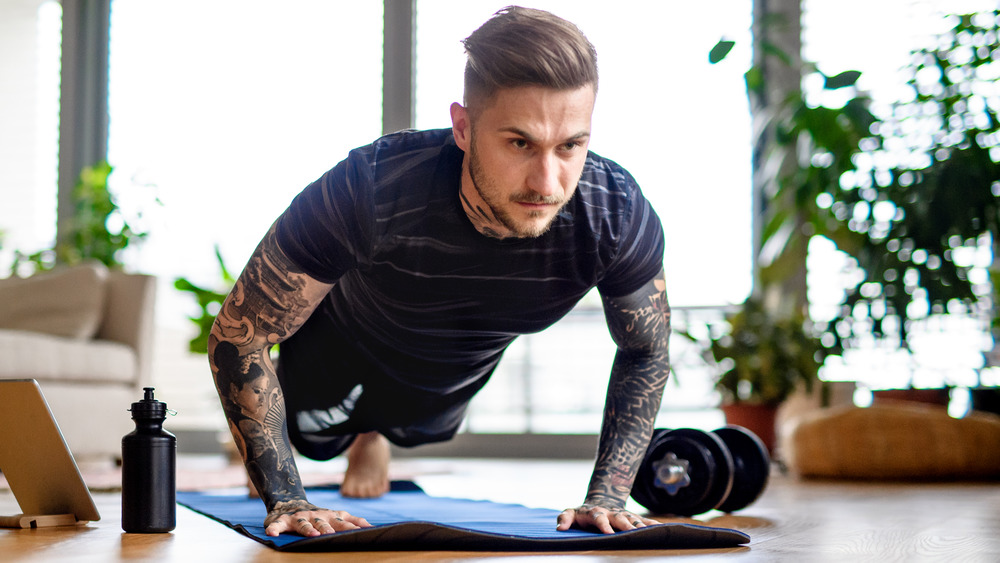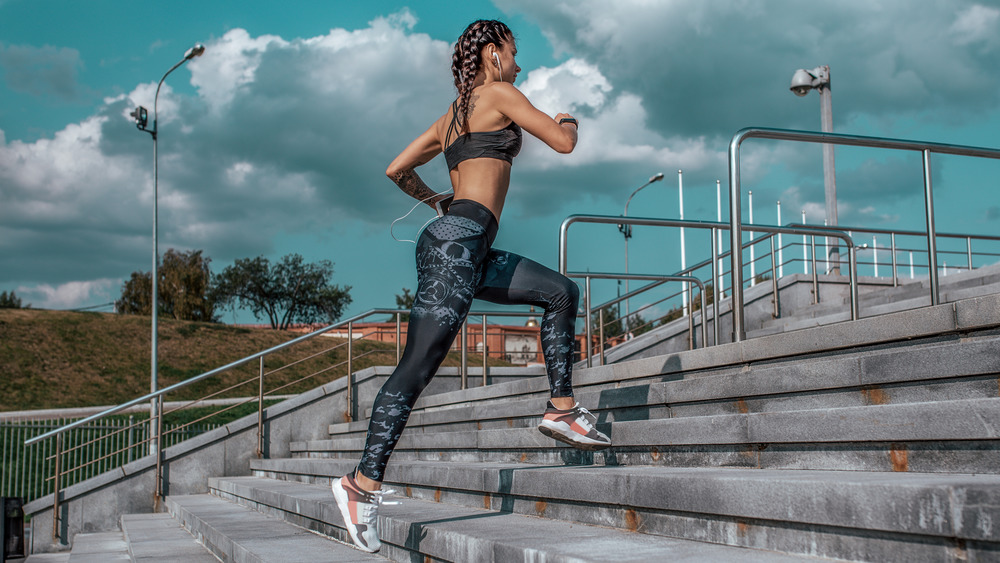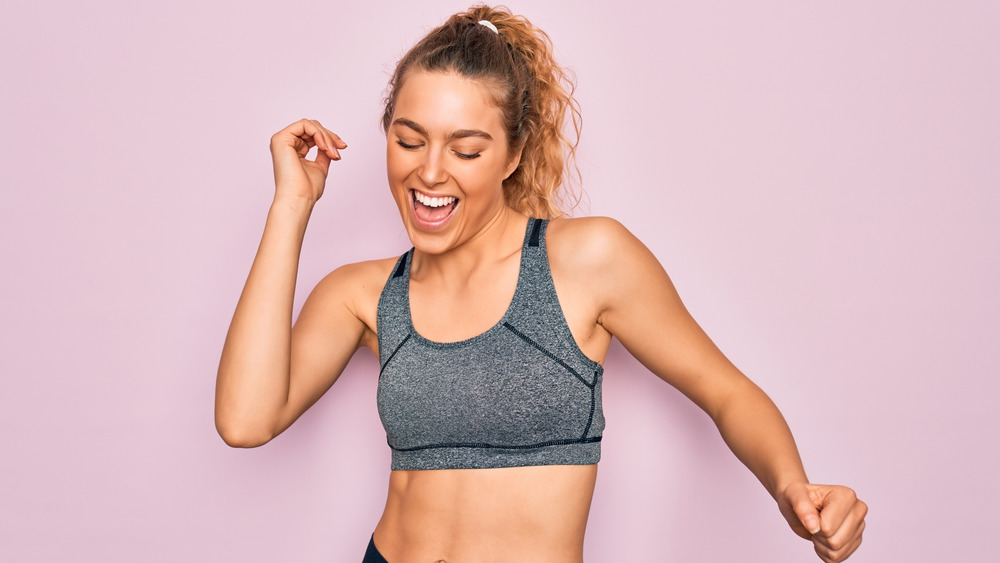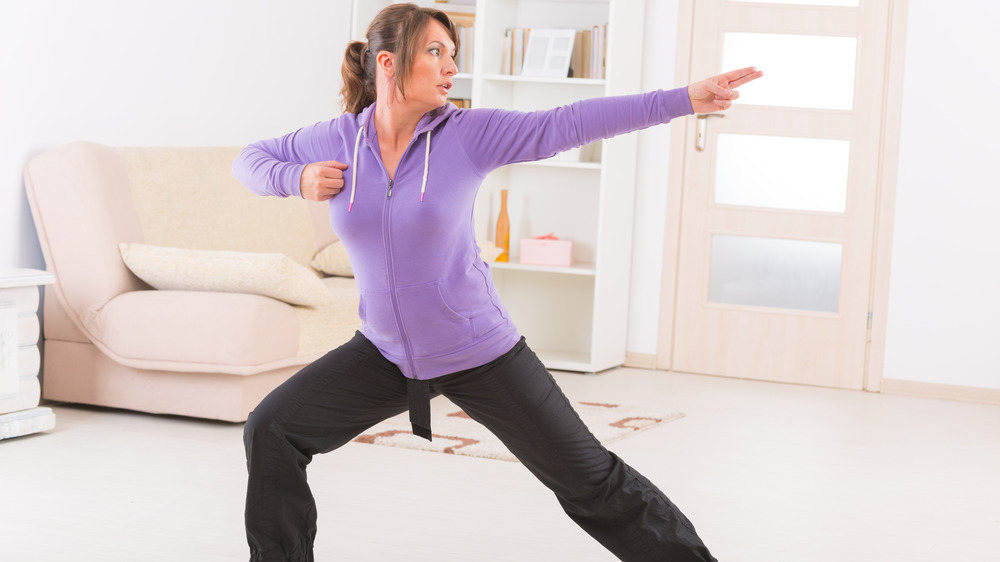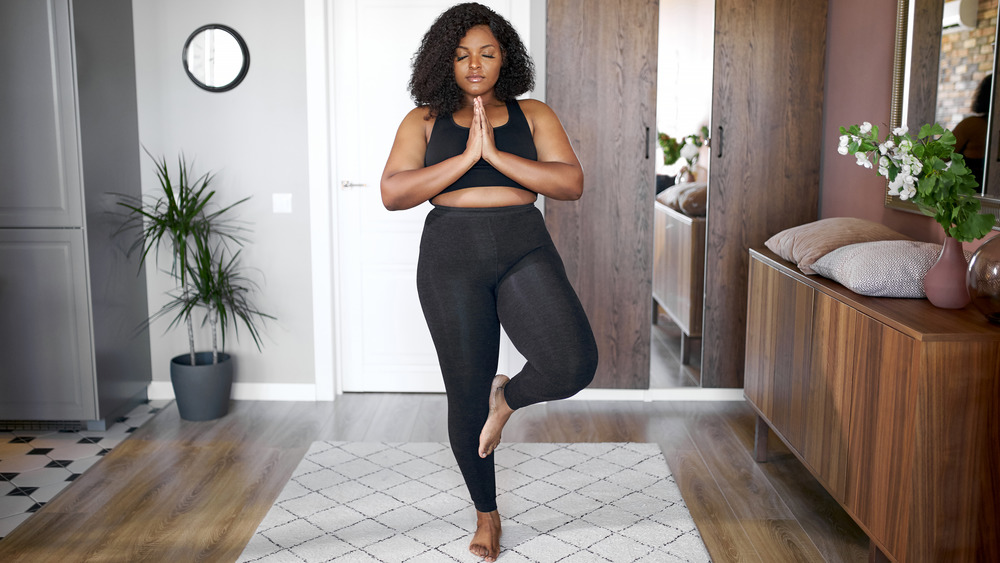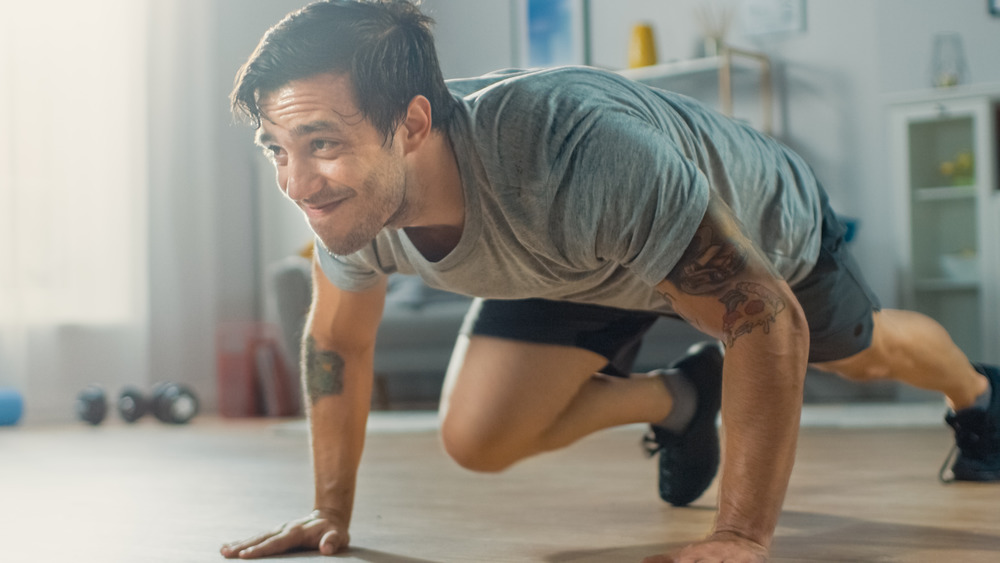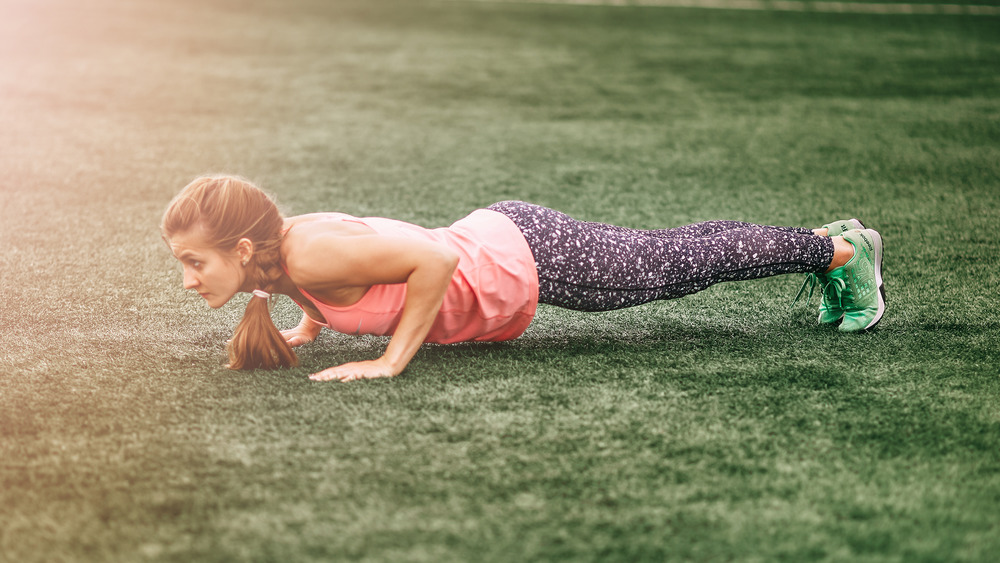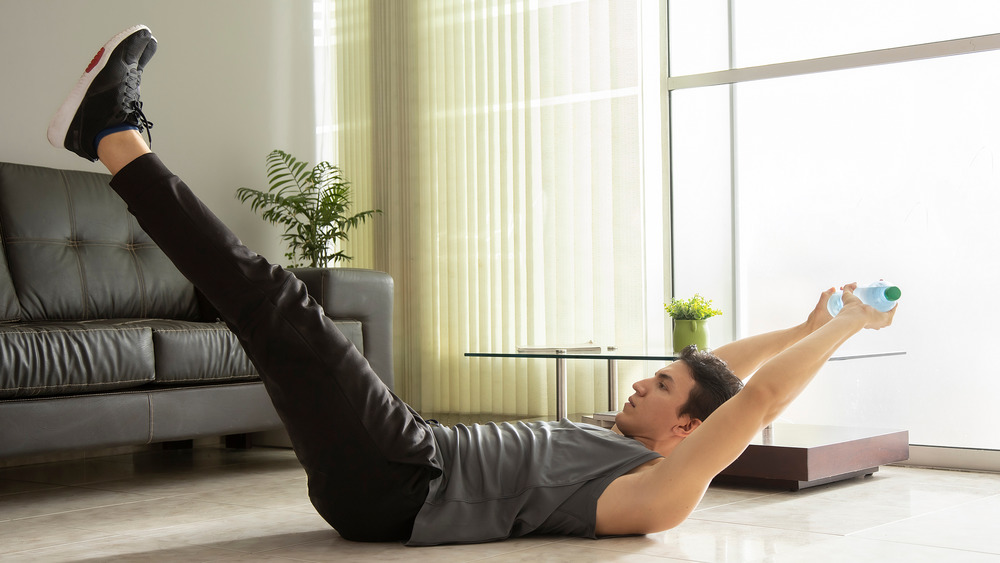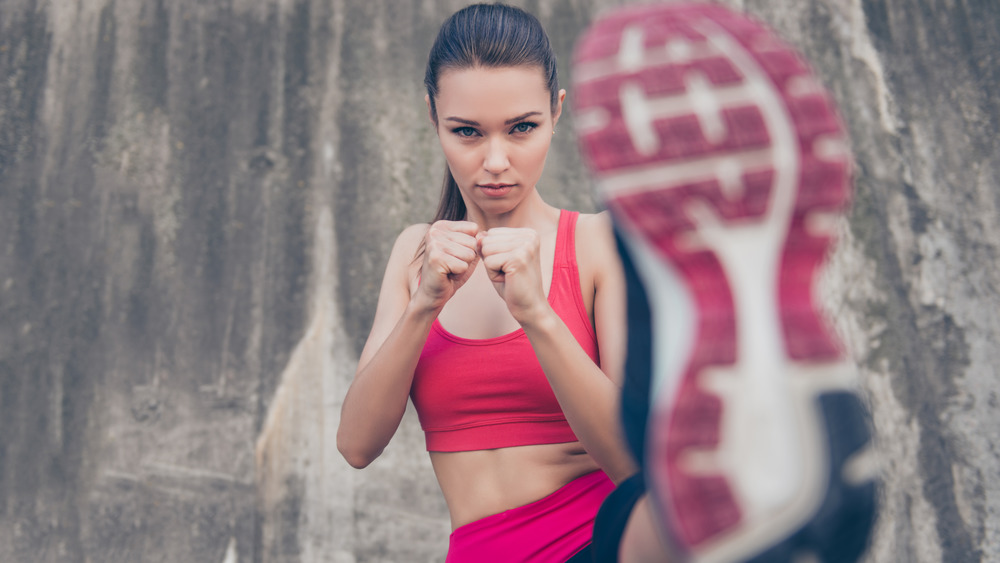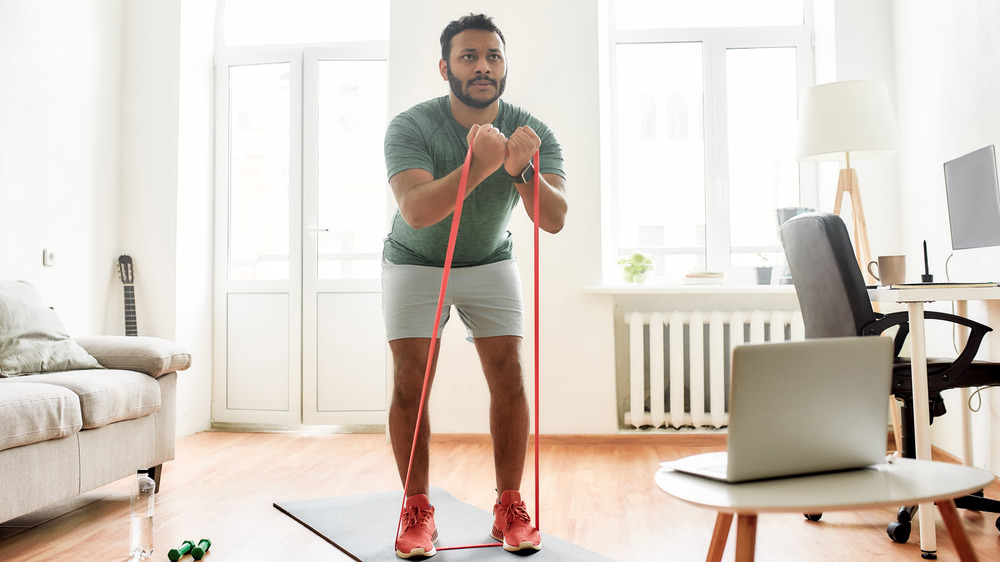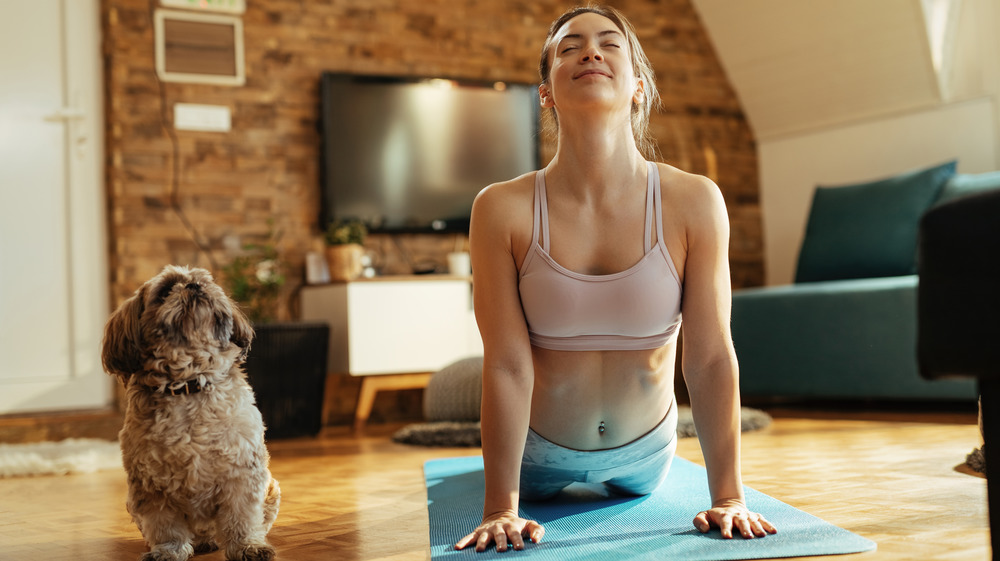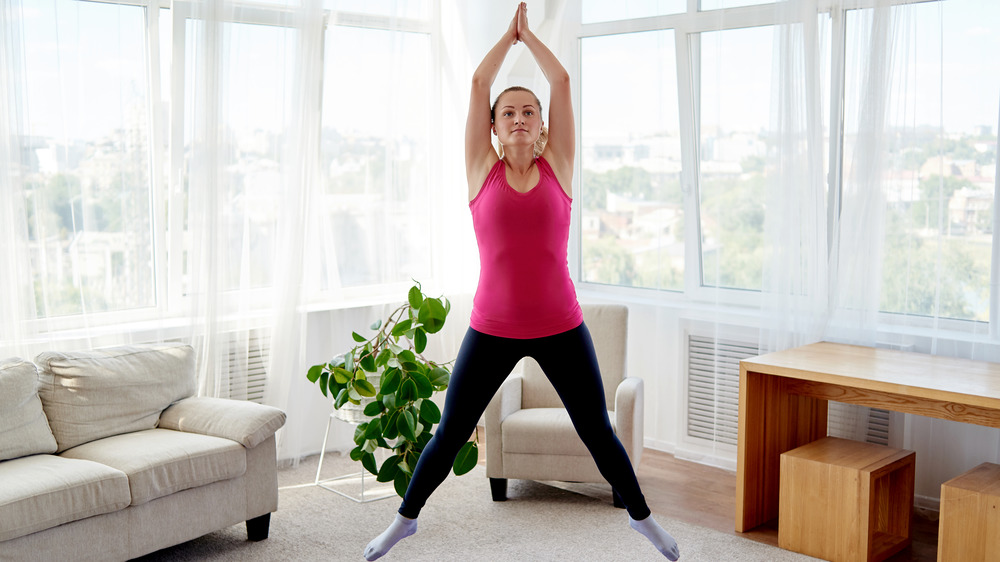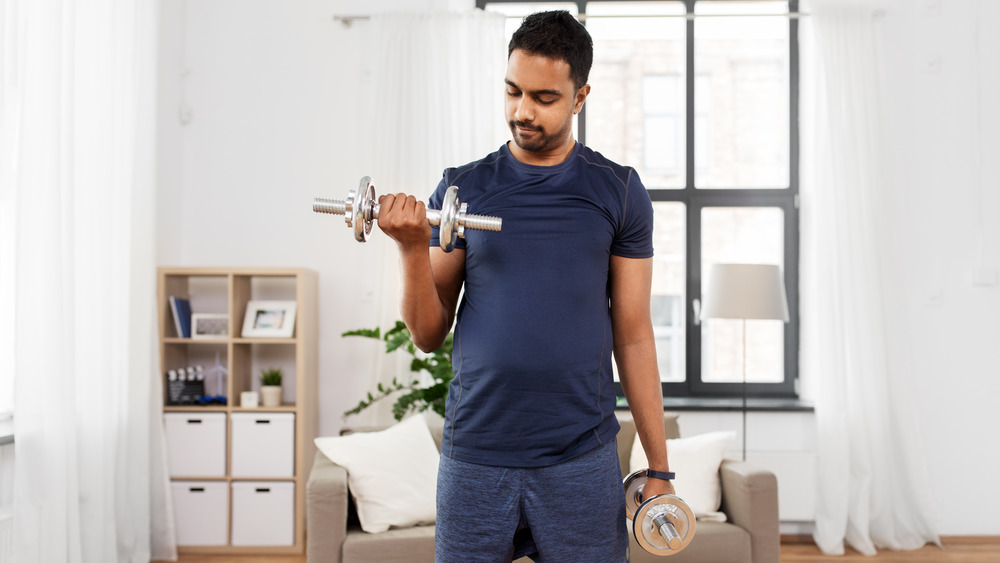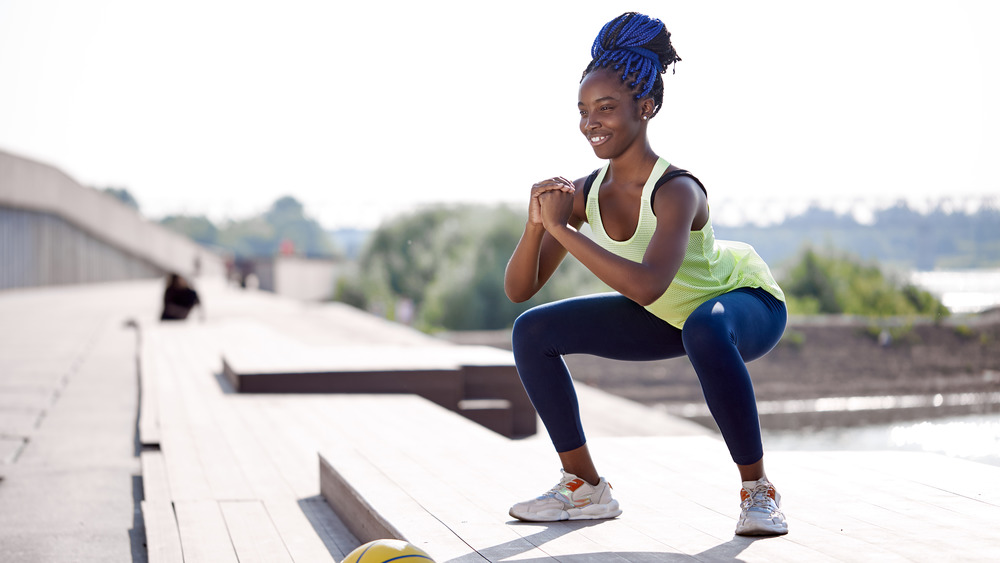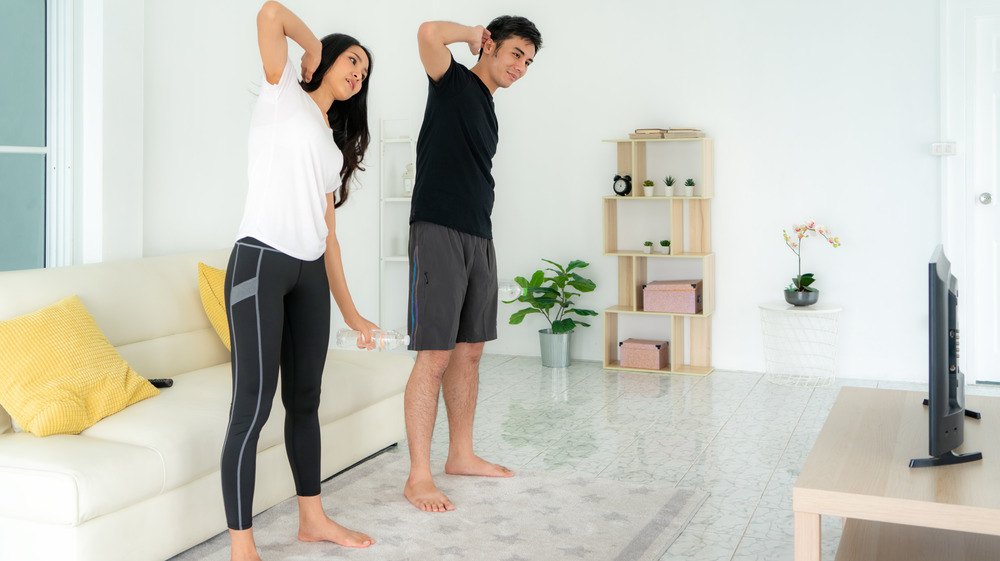The Best Workouts You Can Do Without Going To The Gym
We may receive a commission on purchases made from links.
Working out at the gym can be super motivating to some exercise-minded individuals. Professional equipment and personal trainers paired with the energy of people working out together, often in high-intensity classes where the group and instructor can cheer you through, offer a dynamic that can't quite be replicated at home. However, there are major benefits to working out at home – one of which is uninhibited activity. "Many of us are feeling critical of our bodies and focusing on appearance when we're feeling low can undermine the mental health benefits of working out," personal trainer Martha Munroe told Health Digest.
If you're just getting started, focusing on workouts that are easier and have a lower barrier to entry can be helpful. So, too, can "cultivating an approach to exercise that is more about feeling good moving your body, rather than being really, really good looking," said Munroe.
But which at-home workout is the one? "The best home workout is the same as the best gym workout: the one you will enjoy doing, because it won't feel like work," Rachel Boehm, personal trainer and health and wellness coach, told Health Digest. "This means you will be more inclined to show up for it, and yourself, day after day."
Cardio training
Decades of research has linked physical activity to improved cardiovascular health. According to one report in Circulation, "more active or fit individuals tend to develop less coronary heart disease (CHD) than their sedentary counterparts. If CHD develops in active or fit individuals, it occurs at a later age and tends to be less severe."
When it comes to the kind of physical activity your cardiovascular system needs, it's cardio. "Cardio makes your body, specifically your heart, able to deliver more oxygen to your muscles," Austin Martin, an exercise physiologist, told Women's Health. Cardio training is aerobic, which literally means "with oxygen," according to the Mayo Clinic. With an aerobic workout, your heart rate increases, you breathe faster and more deeply — and that maximizes the amount of oxygen in your blood.
Cardio also aids weight loss, increases stamina, improves immunity, and boosts your mood (via Mayo Clinic). "Getting cardio in with a walk, run, or swim for 30 minutes is a great way to work the cardiovascular system," Marisella Villano, certified trainer and owner of Marvil Fit, told Health Digest. You can also try hiking, cycling, stair-climbing, or even jumping rope for a small initial investment.
Dance workout
Dance has evolved from a performing art to a whole-body workout. According to WebMD, "A 30-minute dance class burns between 130 and 250 calories, about the same as jogging." Dance increases flexibility, muscle strength and tone, endurance, balance, and spatial awareness. And, a 2010 study explained, dance is a highly sustainable form of exercise since it's fun.
For people working from home, dance delivers a needed energy shift. "The convenience of being able to get up from your desk and sweat it out without leaving your home is unparalleled," Laurence Agénor, physical therapist and dance instructor, told Self. "A dance workout is a fun and effective way to break up your day when working from home and boost your endorphins to the rhythm of the beat."
Want to follow someone's lead? YouTube offers a great variety of videos (via Self). Worried about limited space or your effect on others? "There are many low-impact options that are joint and downstairs neighbor friendly," Elaine Starr, professional dancer and owner of Starr Pilates in L.A., told Health Digest. "Try a ballet barre at your kitchen counter or an online salsa class to get your heart rate up in a limited space."
Martial arts training
You don't have to aspire to becoming a black belt to reap the benefits of martial arts. "Martial arts training is one of the best at-home workouts on the planet," Zurriane Bennett, personal trainer and martial artist, told Health Digest. "It helps people with strength, flexibility, balance, mindset, and personal self-defense."
Martial arts is also an option that can be of benefit to all people of all ages, sexes, and cultures. And because there are so many different types of martial arts — karate, jujutsu, kung fu, aikido, judo, hapkido, capoeira, krav maga, kenpo, taekwondo, and more — there truly is one for everyone.
Teaching and training is available online via YouTube — there's even a "Cobra Kai Bo" workout inspired by the smash Netflix hit Cobra Kai. And if you are looking to move beyond training towards mastery (and maybe even get that black belt), there's an online program for you to do just that at the Global Martial Arts University.
Yoga
You'll likely notice a whole host of benefits once you start doing yoga. Physically, a yoga practice can increase your strength, flexibility, and cardiovascular health. Mentally, yoga relieves stress, decreases anxiety and depression, and promotes mindfulness (via Healthline). "One of my favorite things about yoga is how much it can aid in helping me exert my excess energy to destress or slow me down to regain focus and get in touch with my thoughts," Kelly Clifton Turner, yoga instructor and director of education for YogaSix, told Health Digest. "Regardless of what you're looking for in your workout for the day, yoga is a great option for release."
You don't need expensive equipment to practice yoga at home. Many use a mat (which are relatively inexpensive and readily available online) and some yoga blocks. It's also a good idea to keep a blanket and pillow nearby. You can wear whatever makes you comfortable, and there are no shoes required.
Interested in forming a yoga practice? You might find the videos offered by Yoga with Adriene a perfect way to begin. Adriene Mishler offers instructionals on YouTube, which are geared toward those practicing at home of various lengths, intensities, and areas of focus.
Rowing (without a rowing machine)
Collegiate and professional crew teams make gliding through water look effortless. The sport of rowing combines athleticism and grace, and those who row get a fantastic workout. "Rowing is a low-impact form of training that utilizes all major muscle groups, including your legs, core, back, and arms," Hollis Tuttle, certified run coach and director of instructors at CityRow in New York City, told Runner's World.
Rowing machines enable people to get a similar workout from the comfort of their own homes or at their neighborhood gyms. But you don't actually need a machine. How might someone target the same muscle groups as rowing without jumping on a rowing machine? "Some of my go-to exercises are squats, lunges, and pushups," Caley Crawford, director of education for Row House, told Health Digest. "All of these engage the same muscles you would use if you were rowing, which means that these moves would equate [to] a great full-body workout."
Crawford recommends doing bodyweight squats in the first round to warm up. After about a minute of doing squats, transition to Bulgarian split squats, spending 60 seconds on each side. Next, move down to the floor for mountain climbers. Let your arms rest after and do side lunges for about a minute on each leg, followed by another minute of pushups. Then rest!
Bodyweight training
Bodyweight training is a form of strength training that involves only the use of your body weight and its resistance to gravity. According to the Mayo Clinic, it can be just as effective as working with weights or weight machines — and is obviously easy to do at home or outside of a gym.
"I am a huge proponent of bodyweight workouts as an incredible way to build full-body strength and ... move better (functional fitness) and age well," Sarah Turino, holistic personal trainer, yoga instructor, and CEO and founder of The Whole Woman Wellness Formula, told Health Digest. "So often people want to add load (e.g., dumbbells, barbells, et cetera) when your own body weight is extremely effective itself as load."
When bodyweight training, it's important to work out more often. "Using weights, you can afford to [only] get two to four workouts in a week and build muscle," Marco Walker-Ng, certified personal training specialist, told Health Digest. "Since your body weight offers less resistance, to build muscle, you'll want to train a bit more frequently. Start with three workouts a week and aim to increase to five." Wondering where to start? Structure a routine that includes burpees, jump squats, walk out push-ups, and lunges (via Prevention).
Work out with household items
Being stuck at home doesn't have to ruin your weight training. It does mean you have to get creative and use things around your house in place of gym machinery. "For example, you can lay under a table and do a modified pull-up holding into the side of it," Bill Daniels, a California-based personal trainer, told Health Digest.
You can even add household items to most bodyweight exercises to increase the intensity or simulate heavy lifting. "You can hold gallon water jugs in your hands or strap on a backpack full of books and adjust the weight accordingly to your needs," Caley Crawford, director of education for Row House, told Health Digest. "Another great option for upping the intensity of your workout is to use a towel when doing mountain climbers, lunges, and hip bridges."
"Using household items is easy to do, and the easier a routine is, the more likely you will continue with it," Dr. Allen Conrad, a Pennsylvania-based chiropractor, told Health Digest. Want more ideas? Dr. Conrad suggests trying wall squats holding a gallon of milk, standing lunges gripping a full 2-liter bottle, and bicep curls using a canned good from your pantry.
Kickboxing
Combining everything from cardiovascular endurance and strength to balance and agility, kickboxing packs a big punch. The workout gained popularity in 2020 thanks in part to the instant stress release you get from punching and kicking all of those pent up frustrations and anxieties (via Century Martial Arts).
"Kickboxing is one of the best full-body cardiovascular workouts the fitness industry has to offer," Gwen Dannenbaum, personal trainer, kickboxing instructor, and programming director at KickHouse, told Health Digest. A kickboxing workout provides sustained cardiovascular activity which not only relieves stress, but "studies have also shown that kickboxing exercises can also diminish feelings of anxiety, depression, and anger," said Dannenbaum.
If there's any single quality that separates kickboxing from other cardio workouts, it's that it's incredibly fun. "Nothing quite compares to punching out those negative emotions," said Dannenbaum. There's no need for special equipment, though most people would argue the need for some boxing gloves and a punching bag from time to time. Still, it's possible to get a complete kickboxing workout with all the cardio and none of the equipment.
Resistance (band) training
Resistance can be applied throughout a range of motion with elastic resistance bands. These bands come in different strengths, allowing you to make the exercises more or less challenging by changing the resistance. They can be found online at reasonable prices.
Resistance training permits freedom of movement while training stabilizing muscles and the primary movers, helping you get stronger, build muscle, strengthen joints, improve athletic performance, and prevent injury. "By using a band, you are able to perform a variety of resistance exercises without a lot of equipment, in the comfort of your home," Dr. Jordan Duncan, chiropractor and owner of Silverdale Sport & Spine, told Health Digest.
Try bent over rows and banded squats to train key functional movement patterns required in day-to-day activities (via GQ). A lateral walk with elastic band resistance train the muscles on the outside of the hip, which can commonly become weak and lead to knee pain, according to Verywell Fit. An overhead band pull apart trains the arms in an overhead position, which is a common mechanism of injury for those with shoulder pain (via Healthline). And a bridge with elastic band resistance works the glutes.
Pilates
Think you can only do Pilates at a Pilates studio? Think again. Pilates, the exercise craze that focuses on balancing the body and efficiency of muscle movement, is a great at-home workout for many reasons. The only space you need is the size of a mat. And it's a workout using the body's own resistance, so it doesn't require an investment in expensive equipment.
Many Pilates exercises are performed lying down or seated so the body is supported, making it a great choice for anyone dealing with an injury (via HuffPost). And for those of us who are sitting at computers more than usual, upper back strengthening Pilates exercises can provide relief.
"The more you practice the more efficient you will become at engaging the core muscles," Elaine Starr, professional dancer and owner of Starr Pilates in Los Angeles, California, told Health Digest. "As a result, basic Pilates exercises are challenging from level beginner to advanced."
Calisthenics training
Basic calisthenics — the cornerstones of programs like CrossFit and boot camps — have been shown to improve posture and strength and body composition without any major training equipment, a 2017 study in Isokinetics and Exercise Science found. Still, the concept might seem outdated. After all, calisthenics have been around a long time (via Britannica). Most of us remember doing endless jumping jacks and sit-ups in school. Nevertheless, there's something truly timeless about these bodyweight, gymnastic-like exercises.
"[Calisthenics] are basic body moves to build a routine around," Rachel Boehm, personal trainer and health and wellness coach, told Health Digest. "And because they have so many variations, you'll keep your muscles guessing and your mind from getting bored." Consider focusing on, and really trying to master, the squat, the lunge, the deadlift, the upper body push (think: pushups and dips), and the upper-body pull (think: pull-ups and rows).
"Proper form is vital," Boehm said. "Find sources with credentialed trainers that can demonstrate the moves properly, or that have workout routines you can follow while you get to know the moves and your body."
Strength training
Strength training may conjure up images of body builders bench-pressing and dead-lifting. But strength training is about so much more than larger-than-life muscles. "The benefits of strength training are building stronger muscles and bones," Dr. Jasmine Marcus, physical therapist, told Health Digest. And as Joel Freeman, celebrity trainer and creator of the LIIFT4 program, told Shape, "Basic strength training is key to develop a strong muscular foundation. Bones gives our body structure, but muscles are what allow us to move and well."
A strength training workout can involve bodyweight exercises, resistance band exercises, light weights, heavy dumbbells, a barbell — or any combination of these techniques. A 2018 review published in Sports Medicine showed that combining heavy and light loads may improve strength, and that "multiple sets appear to produce superior training benefits compared to single sets."
Ready to get started? Great! Just be careful performing new movements at home since you don't always have someone to spot you or make sure your form is correct. "[And] as with any exercise program, you want to progress gradually so you don't overdo things and potentially injure yourself," advised Marcus.
Functional movement training
Functional fitness involves training your muscles to get better at things they already do to help you function (think: cleaning your house or trekking in groceries) — making it safer and easier to do them every day (via Mayo Clinic). "In order to get a good workout at home, it is important to train the five functional movement patterns," Brittany Robles, OB-GYN and personal trainer, told Health Digest.
These include: the horizontal push (which can be done with pushup variations), the horizontal pull (which can be done with rows), the vertical push (which can be done with pike push-up variations), the knee dominant push (which can be done with squat and lunge variations), and lastly, the hip extension (which can be done with glute bridge variations). "They key is to design workouts that center around these five exercises, all of which can be done with just your body weight," said Robles.
Each of these are compound exercises — that is, they efficiently train multiple muscle groups all at once (via Healthline). When all five are included in a routine, they train almost every single major muscle group in your entire body.
Interval training: HIIT, LIIT, and SIIT
There's more than one kind of interval training. HIIT workouts, or high intensity interval training, involve short but intense physical activities in combination with short rest periods (via Healthline). LIIT, low intensity interval training, uses longer rest periods. Whichever version you choose, you'll experience fat burning, a report in Medical News & Perspectives found. If HIIT or LIIT don't feel like a good fit, you could always try SIIT, or sub-maximal intensity interval training. The premise is simple: less sitting, more moving (via Equinox).
"Integrate SIIT training throughout your day," Ryan Daniel Beck, owner of bodyART Training Studios, told Health Digest. "For every one hour sitting at the desk, there is a regular two to three minute mobility break where you stand, lubricate the joints, promote circulation, recruit gentle muscle contraction and release." The goal is to prioritize exercise.
"Some of the movements you can do, even while working at your desk, include polarity rolls, flexion extensions of the wrists, dorsiflexing ankles, knee to shoulder taps, deep abdominal contraction, active recovery, undulation of the spine, abdominal and quadricep engagement leg lifts, diagonal spiral stretches and lateral stretches," Beck continued.
